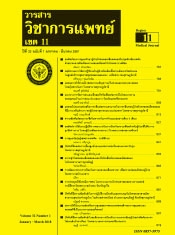Behavior of antibiotics applications. Evidence from the infected upper respiratory tract patients in Donnok Community Health Service Center, Surat Thani Hospital network.
Abstract
This descriptive research aimed to study behavior of antibiotics use in the infected upper respiratory tract patients, with a sample chosen from Donnok Community Health Service Center, Surat Thani Hospital network. The questionnaires were given, during July 14th – August 30th 2017, to the sample to measure the respondents in four main parts, their demographic; their knowledge of antibiotics use; their attitude toward antibiotics use; and their behavior in antibiotics use. The reliability of the research about knowledge; attitude; and behavior, was tested by Cronbach’s alphas, and reported as 0.698; 0.710; and 0.689, respectively. Data were analyzed by descriptive statistics, which were frequency; percentage; means; and standard deviations, and the inferential statistics, which were Independent t-test; one-way ANOVA; and correlation. The results showed that most respondents, or at 49.2 %, had a low level of knowledge about antibiotics use. 38.5 % of the respondents had a medium score, and only 12.5 % possessed a high level of the knowledge. Overall, the respondents had the attitude score towards antibiotics use at an average level, and the behavior score at a good level. Educational level and receiving antibiotics suggestion had a statistically significant (p < 0.05) impact on the behavior of antibiotics use. The positive correlation between the knowledge about and the behavior of antibiotics use was found. (r=0.355 and p > 0.05) But the relationship between the attitude toward antibiotics and the behavior of antibiotics use was not statistically significant. With the result of 87.5% of respondents held low and medium levels of knowledge about antibiotics use, and the positive relationship between the knowledge about and the behavior of antibiotics use, the knowledge about antibiotics promotion should be introduced in public to alleviate the antibiotics abuse problems.
References
Shehadeh Mayadah. Knowledge, attitudes and behavior regarding antibiotics use and misuse among adults in the community of Jordan.A pilot study.Jordan: Saudi Pharmaceutical Journal; 2012; 20:125–133
วสาวี กลิ่นขจร. พฤติกรรมการใช้ยา ปฏิชีวนะของผู้รับบริการในโรงพยาบาลส่งเสริมสุขภาพ ศูนย์อนามัยที่ 3. (ออนไลน์ ). 2554. แหล่งที่มา:http://203.157.71.125/vijai/tong1.20454.pdf. (สืบค้น เมื่อ 25 เมษายน 2560).
ศูนย์เฝ้าระวังการดื้อยาต้านจุลชีพแห่งชาติ. สถานการณเ์ชอื้ดอื้ยาปฏชิวีนะในไทย.(ออนไลน)์. 2558. แหล่งที่มา :http://narst.dmsc.moph.go.th/news001. html. (สืบค้นเมื่อ 25 เมษายน 2560).
จิรชัย มงคลชัยภักดิ์ .การศึกษาความรู้และ พฤติกรรมเกี่ยวกับการใช้ยาปฏิชีวนะของผู้รับบริการ ในร้านยาชุมชนจังหวัดปทุมธานี. วารสารวิชาการ มหาวิทยาลัยอีสเทิร์นเอเชีย.2555; 6(2) : 91-100.
คณะแพทยศาสตร์โรงพยาบาลรามาธิบดี. แนวทางปฏิบัติในการดูแลผู้ป่วยโรคติดเชื้อระบบทาง เดินหายใจส่วนบน.(ออนไลน์).2558 แหล่งที่มา: http:// med.mahidol.ac.th/ramapharmacy. (สืบค้นเมื่อ 25 เมษายน 2560).
ศุภลักษณ์ สุขไพบูลย์ .2559. พฤติกรรม การใช้ยาปฏิชีวนะของผู้รับบริการโรงพยาบาลส่งเสริม สุขภาพตำาบลสร่างโศก อำาเภอบ้านหมอ จังหวัดสระบุรี. (ออนไลน์).2559 แหล่งที่มา:http://journal.nmc.ac.th/ th/admin/Journal/2559Vol4No1_53.pdf. (สืบค้นเมื่อ 25 เมษายน 2560).
Becker, M. H.The health belief model and personal health behavior. Health Education Monographs.1974; 2 : 324-473.





